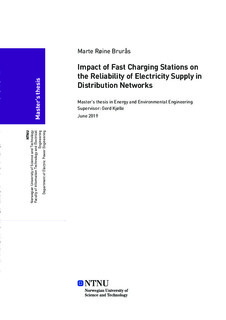| dc.description.abstract | Innen 2050 har Norge en ambisjon om å bli et lavutslippssamfunn med nullutslipp fra transportsektoren. Dette fører til en stor økning i elektrifisert transport, og følgende et behov for lading. Dermed installeres det i dag hurtigladestasjoner med høyt effektbehov i hele Norge.
Denne masteroppgaven undersøker hvilken påvirkning en hurtigladestasjon vil ha på leveringspåliteligheten i kraftnettet. Simuleringsverktøyet FASaD-prototypen er brukt til utføring av leveringspålitelighetsanalyser på et eksisterende distribusjonsnett driftet av Skagerak Nett. En hurtigladestasjon på 10 MW er inkludert i simuleringene. For å finne en optimal lokasjon som minimerer påvirkningen hurtigladestasjonen har på leveringspåliteligheten i nettet, er ulike lokasjoner nær hovedveien i Sande kommune undersøkt. Videre
er det utført en analyse av et "worst-case" scenario. Det er funnet at 29. juni er "worstcase" scenario, ettersom det antas at det maksimale effektbehovet gjennom året for hurtigladestasjonen vil være på denne dagen.
Resultatene fra analysene viser at hurtigladestasjonenes plassering i forhold til transformator og reserveforbindelser vil påvirke leveringspåliteligheten i kraftnettet. Analysene viser at den mest optimale plasseringen i det undersøkte nettet er en hurtigladestasjon som er plassert et stykke ute i nettet og veldig nært en reservekobling. Fra simuleringene er det funnet at de ulike lokasjonene fører til endringer i brytersekvensene ved feil i nettet, noe som påvirker den totale leveringspåliteligheten. Alle de undersøkte alternative ga en stor økning i leveringspålitelighetsindekser. Det ble funnet en økning på 176 % for årlig avbrutt effekt, en 236 % - 258 % økning i årlig avbruddskostnader (KILE) og en økning på 206%
- 237 % i årlig ikke levert energi (ILE).
Fra analyser av "worst-case"-scenarioet ble det funnet at variasjoner i feilfrekvensen i løpet
av en dag har minimal påvirkning på leveringspåliteligheten i kraftnettet. Videre ble det funnet at ILE og avbrutt effekt i løpet av en dag for et kraftnett var veldig avhengig av lastprofilen til hurtigladestasjonen. Fra simuleringer av hver time gjennom et døgn ved bruk av FASaD-prototypen ble det funnet minimal variasjon i KILE. | |
| dc.description.abstract | By 2050, Norway has an ambition of becoming a low-carbon country with a zero-emission transport sector. This leads to a massive increase in electrified transport and the following need for charging. Thus, fast charging stations with significantly high power demands are currently being installed across Norway.
This master thesis investigates the impact a fast charging station will have on the reliability of electricity supply in a power grid. Reliability analyzes by the simulation tool named the FASaD prototype is conducted for an existing distribution grid operated by Skagerak Nett. A fast charging station with a power demand of 10 MW is included in the simulations. Different locations for the fast charging station near the main road in Sande
municipality are explored, in order to find an optimal location that minimizes the impact on the reliability of supply. Further, a reliability analysis of the ’worst-case’ scenario is performed. June 29 is chosen to be the ’worst-case’ scenario, as it is assumed that the maximum power demand for the fast charging station will occur on this day.
The results of the reliability analyzes show that the location for the fast charging station,
relative to the transformer and the reserve connections, will have an impact on the reliability of supply. It is found that the most optimal location in the examined grid is a substation located some distance downstream from the transformer and very close to a reserve connection. From the simulations, it is found that the different locations lead to changes in the switching sequences during a fault, which impacts the reliability of supply.
All the examined alternative locations gave a massive increase in reliability indices. The increase was 176% for the annual interrupted power, while it was found a 236% - 258% increase in the annual cost of energy not supplied (CENS) and a 206% - 237% increase in the annual energy not supplied (ENS) for the different scenarios.
From analyzes of the ’worst-case’ scenario, it was found that the variation in fault frequency during a day had minimal impact on the reliability of supply. Further, it was found that total ENS and interrupted power for the investigated grid depended strongly on the load profile of the fast charging station. From hourly simulations using the FASaD prototype, minimal variation in the CENS during a day was found. | |
